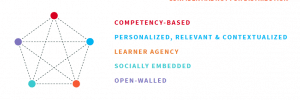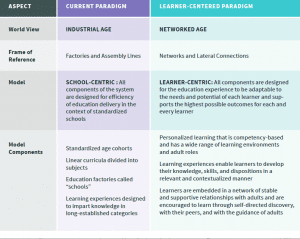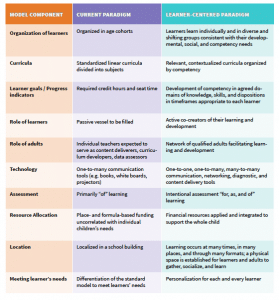Education Re-Imagined
CompetencyWorks Blog
 Convergence, a national organization tackling big social issues, released a fantastic report titled Education Re-Imagined today. The report “seeks to accelerate the growth of learner-centered education” by highlighting pioneers. Convergence defines a learner-centered education as having five elements: competency-based, personalized, learner agency, socially embedded, and open-walled.
Convergence, a national organization tackling big social issues, released a fantastic report titled Education Re-Imagined today. The report “seeks to accelerate the growth of learner-centered education” by highlighting pioneers. Convergence defines a learner-centered education as having five elements: competency-based, personalized, learner agency, socially embedded, and open-walled.
Many of the districts and schools promoted by Convergence are well-developed competency-based models, including Chugach School District (click here for CompetencyWorks case study), Iowa BIG (a visit to BIG by Maria Worthen will be published tomorrow), Lindsay Unified (click here for our case study), Making Community Connections Charter School (click here for our case study), Taylor County School District, and Summit Public Schools. Convergence’s profiles are short one pagers you can easily use with school board, community members, and parents.
The real power of this report is the advisory board, which includes John Jackson, President & CEP Schott Foundation; Randi Weingarten, President, American Federation of Teachers; Becky Pringle, Vice President, National Education Association; Johnny Veselka, Executive Director, Texas Association of Schools Administrators; as well as principals, former superintendents, business leaders, and foundation leaders. You can use this report to demonstrate that these different perspectives and institutions are all “converging” on a common vision for education in America.
You might find parts of the reports helpful to your own communication efforts:
- The description of a learner-centered education as having five elements: competency-based, personalized, learner agency, socially embedded, and open-walled is just about the best I’ve seen. Again, not sure that “agency” is going to be a word that is easily accessible. You might try independence instead.
- The chart comparing the industrial age to the learner-centered paradigm highlights the changes in frame of reference, model, and model components. (Although I’m not sure parents who are scrambling to make a living in service jobs are going to relate to the idea of networks and lateral connections. Check that out before you go too far down that road.)

- The chart describing model components of the traditional system compared to learner-centered is really useful.

—
Let us know if you use any of this report in your community and how you make adjustments so we can continue to strengthen our communication efforts.